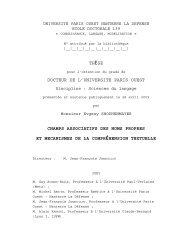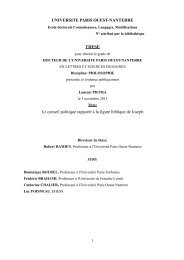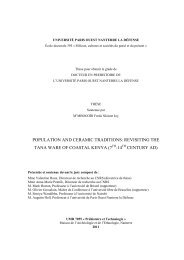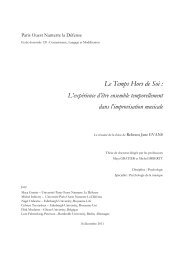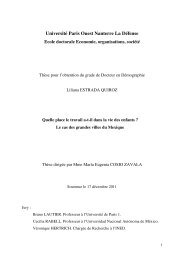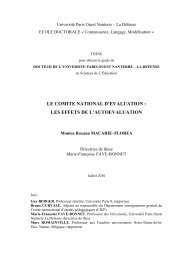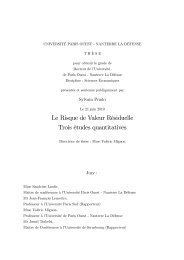Thèse au format PDF - Portail documentaire de l'université de Paris ...
Thèse au format PDF - Portail documentaire de l'université de Paris ...
Thèse au format PDF - Portail documentaire de l'université de Paris ...
Create successful ePaper yourself
Turn your PDF publications into a flip-book with our unique Google optimized e-Paper software.
integrated. Several examples of firms that have adopted this particular mo<strong>de</strong>l of organizations<br />
(DPWN, SNCF, DB) are presented. Finally I discuss if this mo<strong>de</strong>l of organization is<br />
sustainable. On one hand, the European firms of transport and logistics that have adopted this<br />
mo<strong>de</strong>l are comforted in their choice by the policy engaged by the European Union (notably by<br />
advantaging multimodal transports). On the other hand, this form of organization seems to<br />
have already reached its limits in the USA where companies as CSX or FedEx have<br />
abandoned it.<br />
The aim of the third chapter is to verify, econometrically, if the activity of firms belonging to<br />
a logistic and transport group is in line with the activities of their groups. The prece<strong>de</strong>nt<br />
chapter has stated that the business of the logistic and transport groups is significantly<br />
oriented toward the international market and uses, intensively, internet and communication<br />
technologies and multimodal equipment. In or<strong>de</strong>r to verify if affiliated firms share the same<br />
characteristics of their parent groups, I have used two French firm level datasets; the “EAE”<br />
transport survey which gathers in<strong>format</strong>ion on the French transport firms, and the “LIFI”<br />
survey which gathers in<strong>format</strong>ion on the financial linkages between firms. I have selected<br />
eight characteristics of the firms: amount of exports, expense in software, expense in<br />
hardware, number of containers, number of trailers adapted to the transport by train and the<br />
number of warehousemen. For each of these variables, I have tested if the affiliation to a<br />
group modifies their value over a period of six years from 1997 to 2002. I have limited the<br />
study to road h<strong>au</strong>lage firms. First, I have distinguished between the firms affiliated to a<br />
vertical group, the ones affiliated to a horizontal group and single firms. The affiliation to a<br />
horizontal group is associated with a lower growth rate of exports in comparison to other<br />
firms. The affiliation to a vertical group is associated with a higher growth of technology<br />
expenses and of the use of multimodal equipments. Second, and in or<strong>de</strong>r to refine the results, I<br />
have distinguished between firms entering a group (vertical or horizontal) and the one exiting<br />
a group affiliation. I have applied a methodology similar to the one <strong>de</strong>veloped by Bernard and<br />
Jensen (2004) about the behavior of exporting plants. Important differences emerge. Entrants<br />
to a vertical group catch up with the level of expenses on technologies observed in firms that<br />
have belonged to a group during the entire period. Moreover, firms that have always belonged<br />
to a vertical group enjoy a higher growth rate of logistic activities in comparison to the other<br />
groups.<br />
The fourth and last chapter studies the <strong>de</strong>cision of a firm belonging to a group to outsource its<br />
logistics and transports activities. I have based this empirical work on the economic literature<br />
<strong>de</strong>aling with the “make or buy” <strong>de</strong>cision. According to the transaction cost theory, asset<br />
specificity, uncertainty of transactions and their frequency tend to increase the probability that<br />
a transaction takes place within the boundary of the firm. I have used the French survey on<br />
inter-firm relationships (ERIE) to test the assumptions of the transaction cost theory on the<br />
outsourcing <strong>de</strong>cision. In this survey, French firms have been asked to <strong>de</strong>scribe the reasons that<br />
have induced them to establish an intra-group or an extra-group relationship. Fear of <strong>de</strong>lays,<br />
shared expenses in ICT, risk taken by the partner and investment shared are consi<strong>de</strong>red as<br />
factors increasing the asset specificity of transactions. Importance of price, presence of<br />
contract and reputation are assumed to be factors increasing the inclination of a firm to<br />
outsource its activities. In the case of logistics activities, outsourcing <strong>de</strong>cision are linked to the<br />
importance of price and the presence of contracts, on the contrary logistics activities stay<br />
inbound if the partner has to take some risks. In the case of transport activities, outsourcing is<br />
also favored by a particular attention to prices and the presence of contracts, but firms prefer<br />
to outsource their transport bec<strong>au</strong>se of the fear of <strong>de</strong>lays. This last result may reflect the<br />
growing quality of services provi<strong>de</strong>d by the third party logistics.<br />
7



